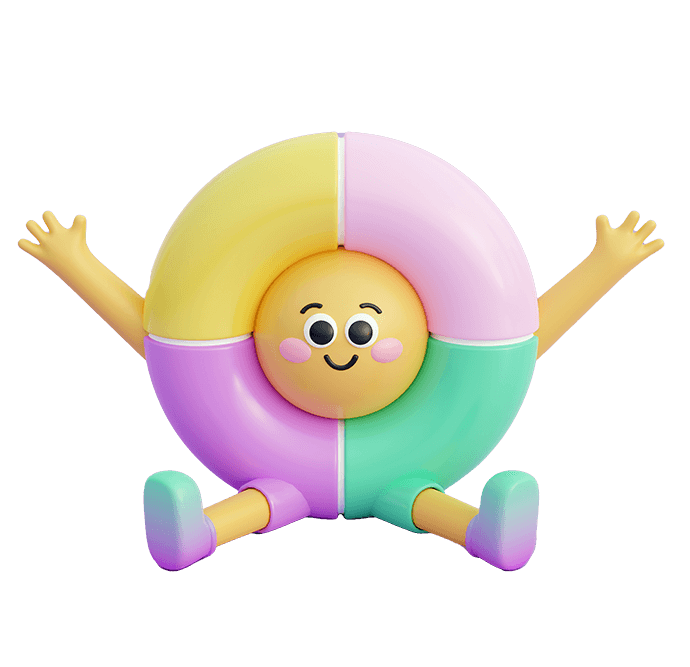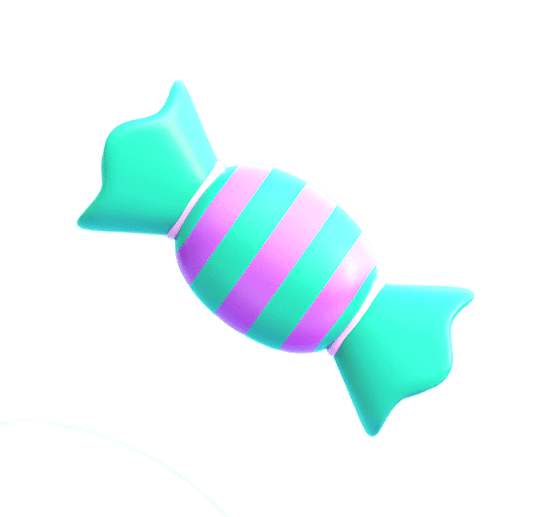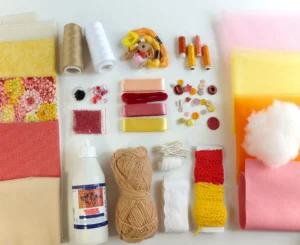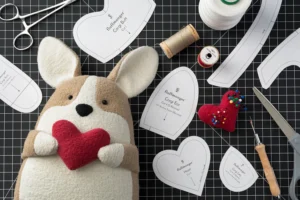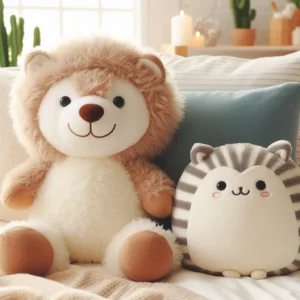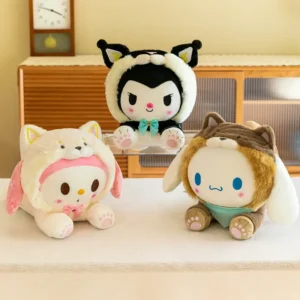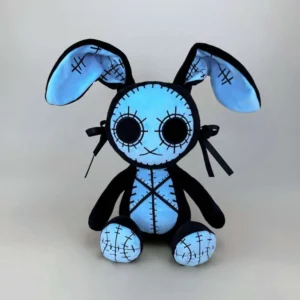Nothing says cozy like your baby snuggling a soft stuffed animal, but hold up—letting them sleep with one too soon can be risky business. You want those cuddly vibes without any safety scares, right? Timing’s everything to keep your little one safe and happy. So, when’s the perfect moment to toss a plush pal into the crib?
Babies can safely sleep with a stuffed animal after 12 months, when suffocation risks drop, per AAP guidelines. Pick small, soft, non-toxic plush toys.
Imagine you’re tucking in your toddler, and they’re clutching their new teddy bear, looking all kinds of adorable. But then you pause—is it safe to leave that plush in the crib overnight? No need to stress! I’m here to spill all the details on when and how to let your baby snooze with a stuffed animal, so you can rest easy too. Let’s get into it!
Why Is Timing Important for Babies Sleeping with Stuffed Animals?
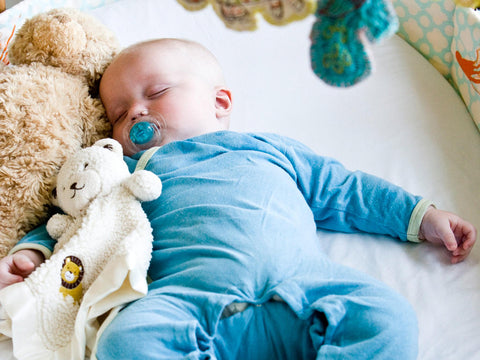
Timing prevents suffocation risks and ensures stuffed animals aid safe sleep.
Why You Gotta Time This Just Right
Keeps Your Baby Out of Harm’s Way
Before 12 months, stuffed animals in cribs can block airways, raising suffocation or SIDS risks. A 2025 AAP report says 20% of SIDS cases involve soft objects like plush toys. A mom waited until her baby was 1 to avoid this. Critically, ask: are you keeping safety first by holding off until the right age?
Unlocks Cozy Benefits
After 12 months, stuffed animals help with self-soothing and emotional growth, making bedtime a breeze. A toddler hugged their plush bunny to calm down during naps, per a parent’s story. Reflect: could waiting for the right time make stuffed animals a sleep superhero for your kiddo?
Avoids Sleep Drama
Tossing a plush in too early might overstimulate your baby or create an unsafe crib setup, messing with their zzz’s. A 7-month-old got fussy with a teddy in the crib, per a dad’s experience. Think: is a stuffed animal helping your baby sleep or causing a nighttime ruckus?
Cuts Parental Worry
Knowing the safe age lets you chill, confident your baby’s sleep setup is secure. A parent slept better after removing plush toys until their baby hit 12 months. Ask: wouldn’t you love the peace of mind that comes with clear safety rules?
Sets Up Long-Term Wins
Proper timing ensures stuffed animals become lasting comfort objects without early risks. A 2-year-old still loves their first safe plush, per a mom. Think: could the right timing make a stuffed animal your child’s lifelong buddy?
| Reason | Why It’s a Big Deal | Real-World Example | Who Benefits |
|---|---|---|---|
| Safety First | Cuts suffocation, SIDS risks | Plush removed until 12 months | Babies, parents |
| Cozy Benefits | Boosts self-soothing, comfort | Bunny calmed toddler naps | Toddlers |
| Better Sleep | Avoids overstimulation | Less fussy 7-month-old | Babies, tired parents |
| Less Worry | Eases nighttime fears | Parent’s stress-free sleep | Anxious parents |
| Long-Term Buddy | Creates lasting comfort object | 2-year-old’s favorite plush | Kids, families |
When Is It Safe for a Baby to Sleep with a Stuffed Animal?
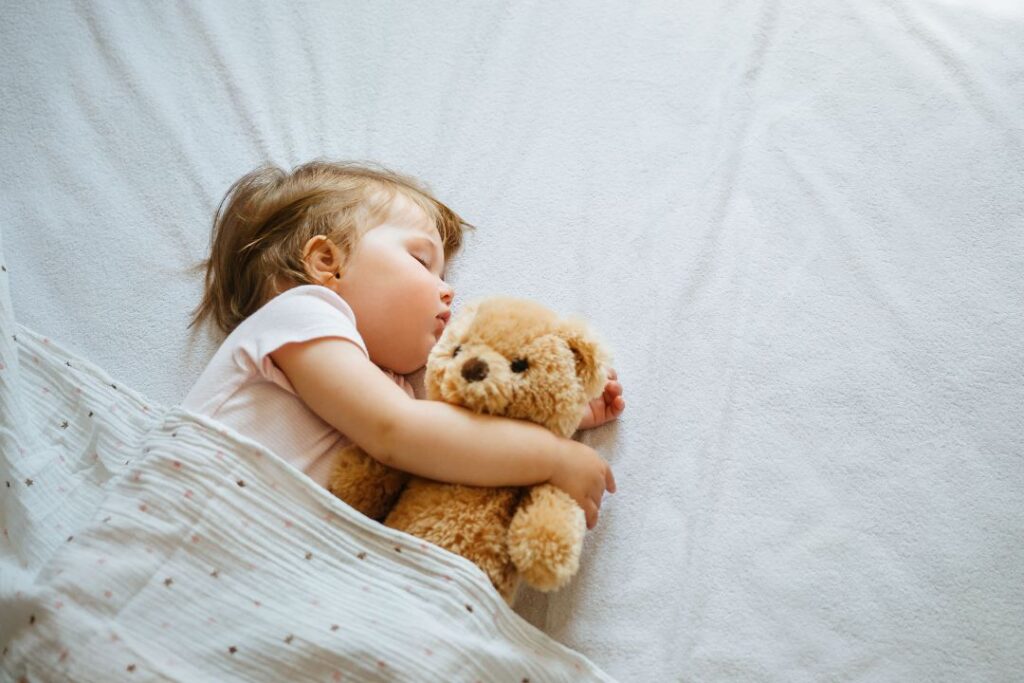
Babies can safely sleep with stuffed animals after 12 months, per AAP.
Nailing the Safe Age for Plush Pals
The Magic 12-Month Mark
The American Academy of Pediatrics (AAP) says 12 months is the sweet spot when babies can roll and push toys away, slashing suffocation risks. A 2025 study backs this, showing SIDS odds drop after 1 year. A mom introduced a plush at 13 months with no issues. Critically, ask: is your baby at least 12 months old to hit this safety milestone?
Motor Skills Ready to Roll
By 12-18 months, babies can move objects and self-soothe, making plush toys safer. A 14-month-old pushed their teddy aside during sleep, per a parent’s story. Reflect: does your baby have the strength and coordination to handle a stuffed animal safely?
Pediatrician’s Thumbs-Up
Some doctors suggest waiting until 18 months for extra caution, especially for preemies or babies with developmental delays. A pediatrician okayed a plush for a healthy 15-month-old but advised waiting for a preemie. Think: have you chatted with your doc for tailored advice?
Nap-Time Test Run
Start with supervised naps after 12 months to see how your baby vibes with a plush toy. A dad tested a small bear during daytime naps before nighttime cuddles. Ask: are you trying naps first to make sure nighttime use is safe?
Watch for Sleep Style
Babies who sleep on their stomach or toss a lot might need closer monitoring with plush toys. A 1-year-old’s active sleep style prompted extra checks, per a mom. Think: does your baby’s sleep style affect how soon you introduce a stuffed animal?
| Factor | Details | Why It Matters | Example |
|---|---|---|---|
| 12-Month Milestone | Lower suffocation risk | AAP-backed safety | Plush at 13 months |
| Motor Skills | Baby can move toys | Prevents entrapment | 14-month-old moved teddy |
| Pediatrician Advice | Custom guidance | Cautious for preemies | Doc’s okay at 15 months |
| Nap-Time Test | Checks safety, comfort | Eases nighttime transition | Bear in daytime naps |
| Sleep Style | Impacts monitoring needs | Active sleepers need checks | Extra checks for active sleeper |
What Are the Risks of Giving Stuffed Animals to Babies Too Early?
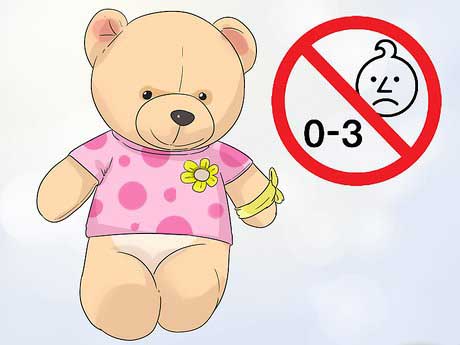
Early stuffed animals risk suffocation, SIDS, allergies, or sleep issues for babies under 12 months.
Why Rushing Plush Toys Is Risky
Suffocation Danger Zone
Babies under 12 months can’t push heavy or bulky plush toys away, risking airway blockage. A 2025 CPSC report ties 15% of infant sleep incidents to soft objects. A mom pulled a plush from her 8-month-old’s crib after learning this. Critically, ask: could a stuffed animal accidentally cover your baby’s face?
Higher SIDS Odds
Soft toys in cribs before 12 months increase Sudden Infant Death Syndrome (SIDS) risks, especially for babies under 6 months. A dad swapped a plush for a pacifier until his baby was 1. Reflect: is waiting until 12 months worth it to lower SIDS risks?
Sleep Cycle Chaos
Plush toys can overstimulate young babies, making it harder to fall or stay asleep. A 9-month-old played with a plush instead of sleeping, per a parent’s story. Think: is a stuffed animal turning bedtime into playtime for your baby?
Allergen Troubles
Stuffed animals can collect dust, pet dander, or mold, sparking allergies or breathing issues in sensitive babies. A parent switched to a hypoallergenic plush for their sneezy 10-month-old. Ask: could a dusty plush be irritating your baby’s nose or skin?
Overcrowded Crib Risks
Adding plush toys to a crib with blankets or pillows creates a cluttered, unsafe sleep space. A mom cleared her 7-month-old’s crib of extras for safer sleep. Think: is your baby’s crib minimalist to keep it safe?
| Risk | What’s the Issue? | Real-World Example | How to Avoid |
|---|---|---|---|
| Suffocation | Blocks breathing | Plush removed at 8 months | Wait until 12 months |
| SIDS Risk | Raises sudden death odds | Pacifier instead of plush | Follow AAP guidelines |
| Sleep Disruption | Overstimulates, delays sleep | 9-month-old played with plush | Keep crib toy-free |
| Allergens | Triggers sneezing, rashes | Hypoallergenic plush used | Choose washable, hypoallergenic |
| Overcrowded Crib | Cluttered, unsafe sleep space | Crib cleared at 7 months | One small plush max |
How Do You Choose a Safe Stuffed Animal for a Baby?
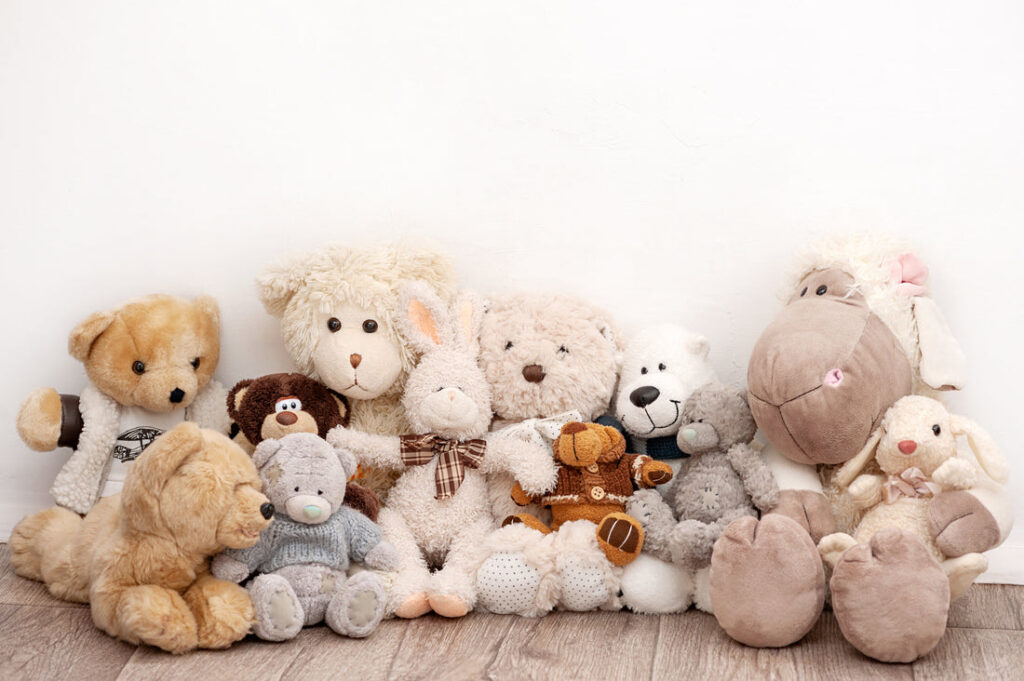
Pick small, soft, non-toxic, hypoallergenic stuffed animals with safety certifications for babies.
Snagging the Safest Plush Buddy
Keep It Small and Light
Choose stuffed animals under 12 inches (ideally 6-8 inches) to avoid smothering risks. A parent picked a 7-inch plush puppy for their 1-year-old’s crib. Critically, ask: is your stuffed animal tiny enough to be a safe sleep buddy?
Go Hypoallergenic
Opt for toys made of non-toxic, hypoallergenic materials like organic cotton or bamboo to dodge skin or lung irritation. A baby with sensitive skin loved a hypoallergenic Kinwin bear. Reflect: are you choosing fabrics that won’t make your baby itchy or sneezy?
Check for Safety Stamps
Look for ASTM F963 or CPSIA certifications to ensure the toy meets strict U.S. safety standards for kids. Kinwin’s plush toys all carry these badges. Think: does your stuffed animal have the safety cred to trust in the crib?
Make Sure It’s Washable
Pick machine-washable toys to keep dust, germs, and allergens at bay. A mom tossed her toddler’s plush in the washer weekly to keep it fresh. Ask: can you easily clean your baby’s plush to keep it hygienic?
Avoid Overstuffed Toys
Super-firm or heavy toys can pose entrapment risks. A parent chose a soft, lightly stuffed plush for their 14-month-old’s naps. Think: is your plush cushy and light enough for safe cuddling?
| Criteria | Why It’s Safe | Example | Where to Find | Cost Range |
|---|---|---|---|---|
| Small Size | No smothering risk | 7-inch plush puppy | Kinwin, baby retailers | $10-20 |
| Hypoallergenic | Prevents allergies, rashes | Organic cotton Kinwin bear | Eco-brands, Amazon | $15-30 |
| Safety Certifications | Meets strict standards | CPSIA-certified plush | Kinwin, trusted stores | $12-25 |
| Washable Design | Keeps germs, dust away | Machine-washable teddy | Most baby brands | $10-20 |
| Lightly Stuffed | Reduces entrapment | Soft, light plush | Specialty retailers | $12-22 |
What Features Make a Stuffed Animal Baby-Safe?
Baby-safe stuffed animals have no small parts, non-toxic fabrics, secure stitching, and soft designs.
Must-Have Features for Plush Safety
Zero Choking Hazards
Skip toys with buttons, beads, or detachable eyes—babies can choke on these. A parent chose a plush with sewn-on features for their 1-year-old. Critically, ask: is your stuffed animal free of tiny parts that could end up in your baby’s mouth?
Non-Toxic, Green Fabrics
Toys should use BPA-free, low-VOC materials like organic cotton or recycled polyester. Kinwin’s plush uses GOTS-certified fabrics, per a 2025 eco-report. Reflect: are you picking fabrics that are safe for your baby and the planet?
Rock-Solid Stitching
Double-stitched seams keep stuffing in and parts from popping off, even with rough toddler tugs. A Kinwin plush held up to a 2-year-old’s wrestling, per a dad. Think: will your toy survive your baby’s love without falling apart?
Super-Soft and Light
Lightweight, squishy toys are safer than heavy, firm ones that could trap a baby. A 13-month-old safely cuddled a feather-light plush bunny. Ask: is your stuffed animal soft and light enough for worry-free snuggles?
No Sharp Edges or Extras
Avoid toys with hard plastic tags or accessories that could poke or irritate. A mom cut off a plush’s plastic tag before crib use. Think: is your plush totally smooth and baby-friendly?
| Feature | Why It’s Safe | Example | Certification | Check For |
|---|---|---|---|---|
| No Small Parts | Prevents choking | Sewn-on eyes teddy | CPSIA | Embroidered features |
| Non-Toxic Fabrics | Safe for skin, breathing | GOTS-certified cotton bear | GOTS, OEKO-TEX | BPA-free label |
| Secure Stitching | No loose stuffing, durable | Kinwin’s double-stitched plush | ASTM F963 | Tight seams |
| Soft, Light Design | No entrapment risk | Feather-light bunny | N/A | Squeeze test |
| No Sharp Extras | Prevents cuts, irritation | Tag-free plush | N/A | Smooth surfaces |
How Can Parents Introduce Stuffed Animals to a Baby’s Sleep Routine?
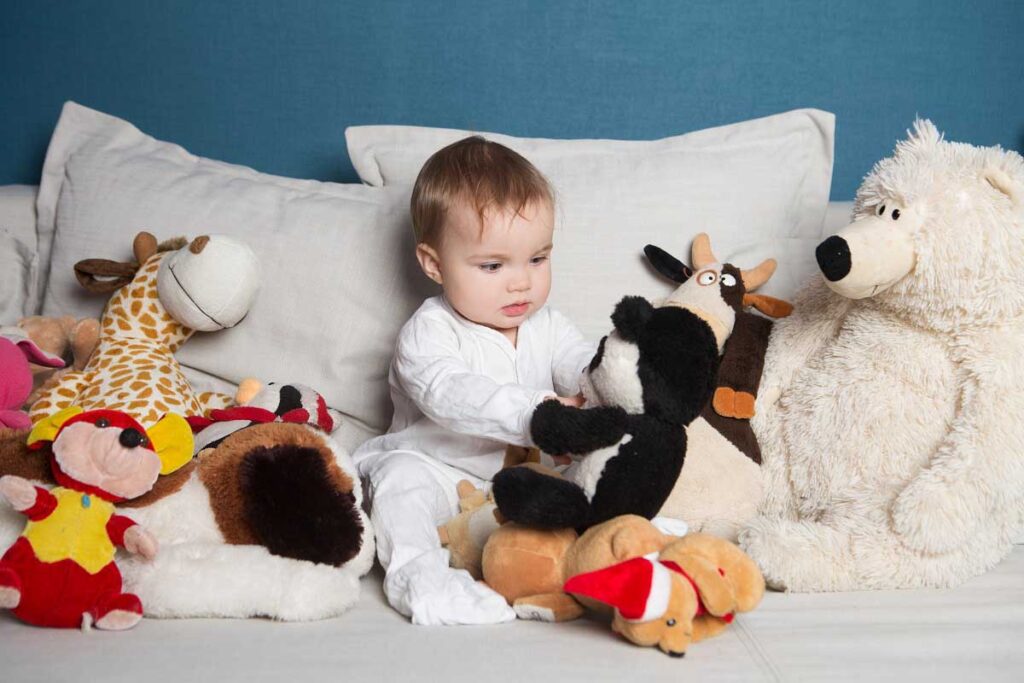
After 12 months, introduce stuffed animals during naps, monitor, and keep crib minimal.
Dive Deeper: Easing Plush Pals into Bedtime
Kick Off with Nap Time
Start by placing a small plush in the crib during supervised naps after 12 months to test comfort and safety. A mom used a plush for her 13-month-old’s naps first. Critically, ask: are you trying daytime naps to make sure the plush is a safe fit?
Keep a Close Eye
Check on your baby during early plush use to spot any entrapment or discomfort. A dad peeked in hourly when his toddler first slept with a teddy. Reflect: are you watching closely to keep those first cuddles safe?
One Plush, No Clutter
Stick to one small stuffed animal in the crib to avoid a crowded, risky sleep space. A parent removed extra toys, keeping just a single bunny. Think: is your baby’s crib clear except for one safe plush?
Build Daytime Bonding
Let your baby play with the plush during the day to get comfy with it before sleep. A 14-month-old loved their daytime bear before naptime snuggles. Ask: are you helping your baby fall in love with their plush during playtime?
Check for Overdependence
Ensure the plush doesn’t become a sleep crutch, making bedtime tough without it. A mom rotated plush toys to avoid this with her 1-year-old. Think: are you balancing comfort with healthy sleep habits?
| Step | How It Helps | Example | Timeframe | Pro Tip |
|---|---|---|---|---|
| Nap-Time Intro | Tests safety, comfort | Plush in 13-month-old’s naps | 1-2 weeks | Supervise closely |
| Close Monitoring | Spots risks early | Hourly checks for teddy | First month | Use a baby monitor |
| Minimal Crib | Reduces clutter, risks | One bunny only | Ongoing | Clear out extras |
| Daytime Bonding | Builds plush familiarity | Daytime bear play | 1-2 months | Play together |
| Avoid Overdependence | Prevents sleep crutch | Rotated plush toys | Ongoing | Mix up comfort items |
Are There Benefits to Babies Sleeping with Stuffed Animals?
Stuffed animals help babies self-soothe, ease anxiety, and grow emotionally after 12 months.
Why Plush Toys Are Bedtime MVPs
Master Self-Soothing
A stuffed animal helps toddlers calm themselves during sleep, cutting down on midnight meltdowns. A 2-year-old hugged a plush elephant to drift back to sleep, per a mom. Critically, ask: could a plush pal help your toddler chill out at bedtime?
Soothes Separation Anxiety
Plush toys offer comfort when parents aren’t around, especially during naps or daycare. A 16-month-old clung to a teddy during preschool naps, feeling secure. Reflect: can a stuffed animal ease your baby’s stress when you’re not there?
Grows Emotional Skills
Cuddling and “caring” for a plush toy builds empathy and bonding skills. A 2025 study says toddlers mimic parenting with toys, like a 2-year-old “feeding” their bear. Think: is a plush helping your child learn to care for others?
Boosts Sleep Independence
A familiar stuffed animal makes bedtime feel safe, helping kids sleep solo without fuss. A 1.5-year-old slept through the night with their bunny pal. Ask: could a plush make bedtime smoother for your toddler?
Sparks Imagination
Plush toys encourage pretend play, even during quiet sleep times, boosting creativity. A 2-year-old “talked” to their plush before bed, per a dad. Think: is a stuffed animal sparking your child’s imagination?
| Benefit | How It Rocks | Example | Age Range | Long-Term Win |
|---|---|---|---|---|
| Self-Soothing | Calms without parents | Elephant for 2-year-old’s sleep | 12-36 months | Fewer wake-ups |
| Eases Anxiety | Comforts during separation | Teddy at daycare naps | 12-24 months | Less clinginess |
| Emotional Skills | Builds empathy, care | “Feeding” bear at 2 years | 18-36 months | Social growth |
| Sleep Independence | Promotes solo sleep | Bunny for full nights | 12-36 months | Easier bedtimes |
| Imagination | Sparks pretend play | “Talking” to plush before bed | 18-36 months | Creative thinking |
Wrap-Up: Snag the Perfect Plush with Kinwin
Letting your baby sleep with a stuffed animal is a game-changer for cozy, happy bedtimes, but wait until 12 months, pick a small, safe, hypoallergenic plush, and introduce it slowly to keep things worry-free. At Kinwin, we’re obsessed with crafting eco-friendly, baby-safe stuffed animals using non-toxic, sustainable fabrics that your little one will adore. Need a custom plush or more tips for safe cuddles? Hit up Kinwin today for a quote or to design the ultimate snuggle buddy. Let’s make your baby’s sleep time the coziest, safest ever!

